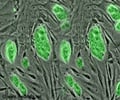What is an Embryonic Stem Cells?
Human embryonic stem cells are derived from fertilized embryos less than a week old. This can be done by using blastocysts obtained from donated, surplus embryos produced by
Such embryos are produced in the 'test-tubes' for infertile couples, but often more numbers of embryos are produced than needed and stored in case there is
Embryonic stem cells, derived from
They also have the capacity to keep proliferating indefinitely in a culture medium.
Embryonic stem cells are derived from the cells that make up the inner cell mass of the blastocyst. Embryonic stem cells are undifferentiated cells that are unlike any specific adult cell and are of great interest to science because of their ability to develop into virtually any other cell type made by the
These embryonic stem cells can proliferate indefinitely in culture and can produce unlimited source of cells that can differentiate into specific and important adult cells such as
Mouse embryonic stem cells are capable of generating to any cell types in the body. So, they are called as pluripotent and have unlimited potential as far as
Important application of human embryonic stem cell would be in the field of
Embryonic stem cells help to know the developmental events in humans, which would help to prevent or treat








